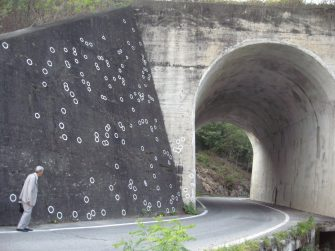On July 26, 1950, the No Gun Ri Massacre began. For three days, US soldiers butchered 400 Korean refugees hiding in a tunnel. The US and South Korea denied this history until 1999. No Gun Ri is just the most famous of 200 reported civilian massacres by US troops in the south. 🧵 

As US & S Korean soldiers fled south in the early days of the war, US commanders ordered troops to treat refugees inside battle zones as “enemy agents.”
According to a 7/25/1950 Air Force memo by Col. Turner Rogers: "The army has requested we strafe all civilian refugee parties"
According to a 7/25/1950 Air Force memo by Col. Turner Rogers: "The army has requested we strafe all civilian refugee parties"

On July 25th, US troops evacuated hundreds from No Gun Ri and surrounding villages.
The next day, the refugees were stopped at a railroad bridge and ordered onto the tracks where soldiers searched them for weapons. Afterwards, US warplanes shot and bombed the resting villagers.
The next day, the refugees were stopped at a railroad bridge and ordered onto the tracks where soldiers searched them for weapons. Afterwards, US warplanes shot and bombed the resting villagers.

Afterwards, US soldiers corralled the survivors into the tunnel and shot at the people from both ends.
For the next two days, anyone seen moving in the tunnel was shot. Bullet holes from the massacre could still be seen on the bridge in 2000.
For the next two days, anyone seen moving in the tunnel was shot. Bullet holes from the massacre could still be seen on the bridge in 2000.

"They were checking every wounded person and shooting them if they moved" - Chung Ku Hun, survivor, age 17 in 1950
"We just annihilated them." - Norman Tinkler, ex-machine gunner
More witness testimony can be read here: pulitzer.org/winners/sang-h…
washingtonpost.com/wp-srv/inatl/l…
"We just annihilated them." - Norman Tinkler, ex-machine gunner
More witness testimony can be read here: pulitzer.org/winners/sang-h…
washingtonpost.com/wp-srv/inatl/l…

After Rhee Syngman was ousted in 1960, No Gun Ri survivors spoke out for the 1st time. Over 30 petitions to South Korea & the US were filed in 40 years. All were ignored or denied until an Associated Press story based on 24 survivors + 12 soldiers’ accounts was published in 1999. 

The No Gun Ri revelations sparked separate US & South Korean investigations. The US acknowledged the incident but claimed it had no prior knowledge of the massacre or evidence of orders to shoot. The South Korean report, along with later AP & CBS reporting, contradicted this. 





The No Gun Ri revelations opened the floodgates to other Korean War survivors' testimonies, which had been suppressed by decades of US-backed fascism and the anti-free speech National Security Law.
In 2005, the South Korean Truth and Reconciliation Commission was formed.
In 2005, the South Korean Truth and Reconciliation Commission was formed.

No Gun Ri is the most famous US massacre from the Korean War, but it's not the only one.
No Gun Ri exposes the US myth of "saving" or "liberating" Korea. In practice, the US saw all Koreans as "gooks"— racially inferior threats to be controlled or eliminated.
No Gun Ri exposes the US myth of "saving" or "liberating" Korea. In practice, the US saw all Koreans as "gooks"— racially inferior threats to be controlled or eliminated.

The US adapted its anti-insurgency playbook from Korea to its wars in Vietnam, Iraq and beyond. Just as the victims and survivors of No Gun Ri deserve justice, so too do all victims of US imperialism. The only true justice for all is an end to this despicable empire. 

• • •
Missing some Tweet in this thread? You can try to
force a refresh























